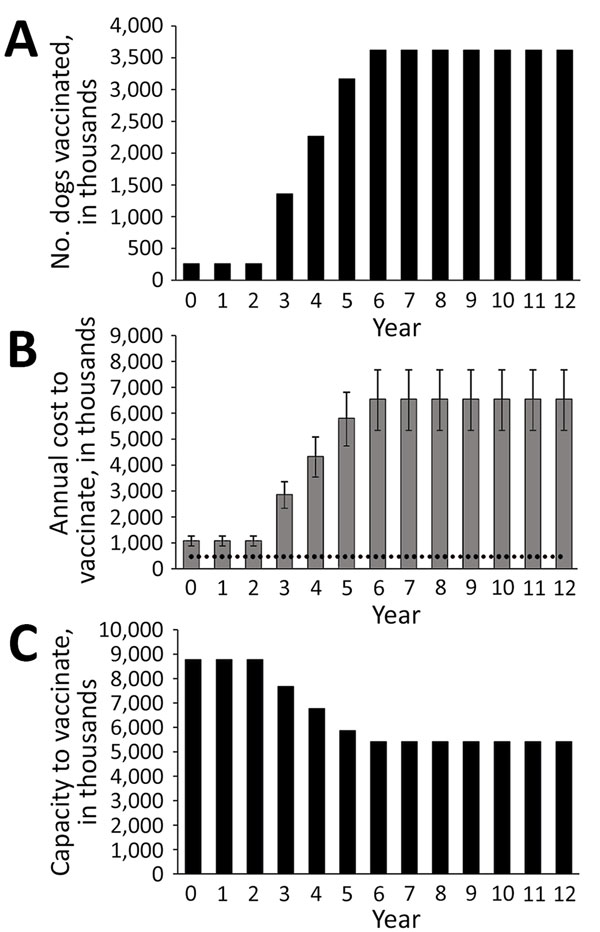Volume 23, Number 12—December 2017
Research Letter
Tool for Eliminating Dog-Mediated Human Rabies through Mass Dog Vaccination Campaigns
Figure

Figure. Illustrative results from the planning aid tool for controlling dog rabies through dog vaccination using input data, Kenya, 2016. A) Number of annual dog vaccinations required in accordance with World Health Organization recommendations. The tool assumes a threshold of 70% of dog vaccination during 7 years as a conservative estimate to eliminate dog-mediated rabies. The actual proportion of the dog population that needs to be vaccinated depends on local conditions of rabies transmission (10). Based on field data, Kenya estimates that 3 consecutive years of 70% coverage of dog vaccination would end dog–dog rabies transmission. The estimate by Hampson et al. (1) estimate of 523 annual deaths was based on active surveillance in eastern Kenya; current passive surveillance reports higher bite rates, so the estimate probably represents a lower bound of the number of deaths that could be avoided through mass dog vaccination. B) Total annual cost (US $) of dog vaccination. Error bars indicate 95% CIs. Horizontal dotted line indicates current spending for dog vaccination. C) Net dog vaccination capacity (i.e., total number of dogs per year minus the number of dogs Kenya needs to vaccinate to achieve the dog vaccination coverage goal). If the number is positive, the country has enough capacity to vaccinate; if negative, the country needs more vaccinators, increased vaccination efficiency, or more campaign days. The estimated annual costs are based on the cost per dog vaccinated; excess vaccinator capacity is not included in the aggregate costs.
References
- Hampson K, Coudeville L, Lembo T, Sambo M, Kieffer A, Attlan M, et al.; Global Alliance for Rabies Control Partners for Rabies Prevention. Estimating the global burden of endemic canine rabies. [Erratum in: PLoS Negl Trop Dis. 2015;9:e0003786]. PLoS Negl Trop Dis. 2015;9:e0003709. DOIPubMedGoogle Scholar
- Knobel DL, Cleaveland S, Coleman PG, Fèvre EM, Meltzer MI, Miranda MEG, et al. Re-evaluating the burden of rabies in Africa and Asia. Bull World Health Organ. 2005;83:360–8.PubMedGoogle Scholar
- World Health Organization. WHO Expert Consultation on Rabies. Second report [cited 2016 Mar 30]. http://apps.who.int/iris/bitstream/10665/85346/1/9789240690943_eng.pdf
- World Health Organization. Rabies vaccines: WHO position paper. Wkly Epidemiol Rec. 2010;85:309–20 [cited 2017 Oct 5]. http://www.who.int/wer/2010/wer8532/en/
- Rupprecht CE, Hanlon CA, Hemachudha T. Rabies re-examined. Lancet Infect Dis. 2002;2:327–43. DOIPubMedGoogle Scholar
- Vigilato MAN, Clavijo A, Knobl T, Silva HMT, Cosivi O, Schneider MC, et al. Progress towards eliminating canine rabies: policies and perspectives from Latin America and the Caribbean. Philos Trans R Soc Lond B Biol Sci. 2013;368:20120143. DOIPubMedGoogle Scholar
- Wallace RM, Undurraga EA, Blanton JD, Cleaton J, Franka R. Elimination of dog-mediated human rabies deaths by 2030: needs assessment and alternatives for progress based on dog vaccination. Front Vet Sci. 2017;4:9. DOIPubMedGoogle Scholar
- Lembo T, Hampson K, Kaare MT, Ernest E, Knobel D, Kazwala RR, et al. The feasibility of canine rabies elimination in Africa: dispelling doubts with data. PLoS Negl Trop Dis. 2010;4:e626. DOIPubMedGoogle Scholar
- Republic of Kenya Ministry of Health and Ministry of Agriculture. Strategic plan for the elimination of human rabies in Kenya 2014–2030 [cited 2017 Jun 1]. http://zdukenya.org/wp-content/uploads/2012/09/National-Rabies-Elimination-Strategy.pdf
- Zinsstag J, Dürr S, Penny MA, Mindekem R, Roth F, Menendez Gonzalez S, et al. Transmission dynamics and economics of rabies control in dogs and humans in an African city. Proc Natl Acad Sci U S A. 2009;106:14996–5001. DOIPubMedGoogle Scholar
1Current affiliation: Pontificia Universidad Católica de Chile, Santiago, Chile.